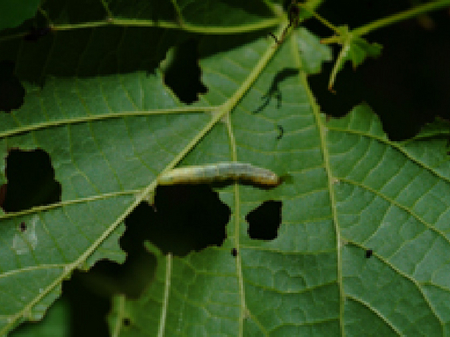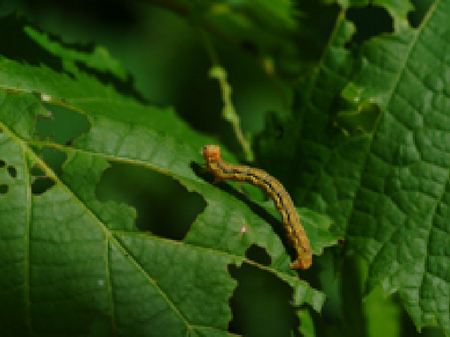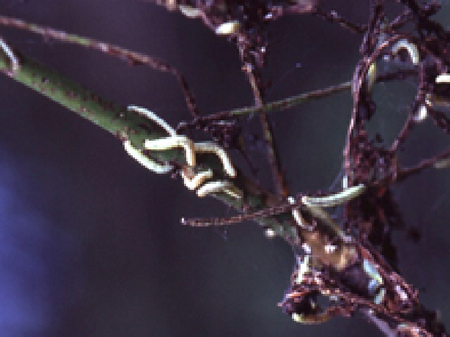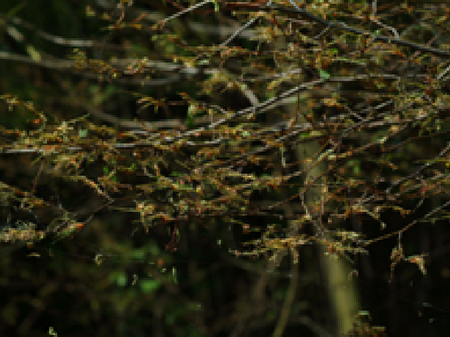Winter moth
Operophtera brumata
Appearance
Among the butterflies (Lepidoptera), the Small Frost Moth belongs to the family of moths (Geometridae), which are characterized by "humping" during locomotion (spanner-like locomotion) and when the caterpillars are disturbed.
Moth: The male is an inconspicuous brown-gray butterfly with about 25 mm wingspan. The female is gray in color and 6-7 mm long, but has only wing stubs and is flightless.
The caterpillars are dark gray at first, later they acquire a light green coloration with yellowish longitudinal stripes.



Biology
Hibernation takes place as an egg in bark cracks of the trees. The caterpillars hatch in spring already at the beginning of budding and eat young leaves, flowers and fruits. When the caterpillars are fully grown (about 2.5 cm long), they leave the tree and retreat to the uppermost soil layer (in May). After pupation, the adult butterflies emerge in the fall around the end of October with the first frost nights. Since the butterflies' proboscis is regressed, they do not ingest food and live only a few days. After mating, the flightless females climb up the trunks of trees to lay eggs and deposit up to 300 eggs in the outer crown area, which are initially light green and later turn reddish in winter.
Damage symptoms
The flower and leaf buds do not unfold, they are partially spun and hollowed inside. In the flowers, the pistils and stamens are eaten away and the flower is destroyed as a result. The leaves initially show pitting; in more severe infestations they are eaten down to the leaf veins (bare leaf feeding). Young fruits are also damaged in many cases. In pome fruit, the flesh is affected; in stone fruit, especially cherry, the pit is also affected (spoon feeding). The much rarer great frost moth(Erannis defoliaria) and other caterpillars produce the same damage symptoms.



Economic importance
Heavy occurrence of the frost moth can result in considerable crop losses, as the feeding of the caterpillars causes large quantities of flowers and young fruit to fail. In home gardening and fruit growing, the frost moth occurs regularly in certain areas (so-called frost moth sites). In intensive cultivation, especially in organic farming, increased infestation by the frost moth can be observed in some years.
Prevention and control
- Encourage and protect natural counterparts, such as predatory insects, spiders, ichneumon flies, birds.
- Use of glue rings from late October to January to intercept flightless females crawling up the tree trunk. This can prevent egg laying. Do not forget to remove the glue rings again in January.
- Winter or budding sprays (oil preparations) against "overwintering animal pests" can successfully destroy the laid eggs. Make sure that all parts of the tree are thoroughly wetted! (see list of plant protection products approved in Austria).
- Treat against the young caterpillars with plant protection products before or at the latest shortly after flowering, if necessary. Economic damage threshold for visual inspections: 5-10 caterpillars per 100 leaf tufts.
- In addition to synthetic pesticides, Bacillus thuringiensis preparations can also be used against the young caterpillars (if possible before flowering).
- Once the caterpillars have reached a size of 2 cm, chemical treatment is no longer appropriate, as they are expected to migrate soon.
Last updated: 21.03.2025
automatically translated